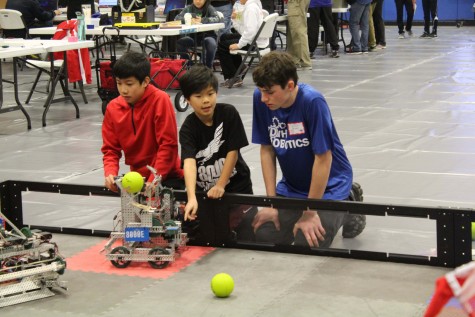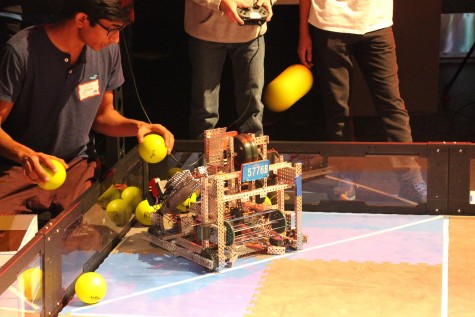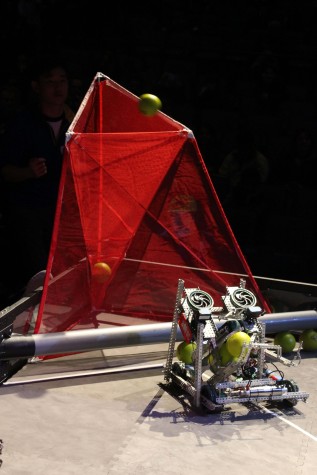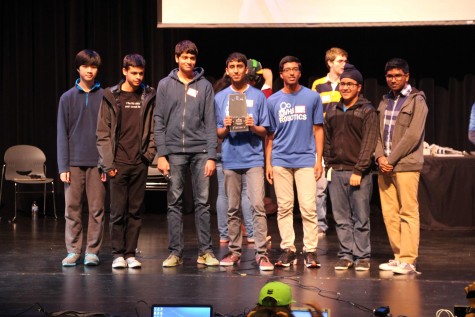Robotics Competition
After six years of competing in VEX competitions throughout the country, the DHS Robotics club hosted their first competition this past Saturday–Gael Force Battle of the Bay.
Starting at seven a.m., twenty-eight teams from almost fifteen Bay area schools crowded into the old gym to set up their robots and work out any last minute glitches in the practice arena. Although there was only one practice area for all the teams to share, the atmosphere was friendly and everyone seemed excited, but nervous, for the day-long competition to start.

Similar to organizations such as Destination Imagination and Odyssey, the FIRST and VEX create a challenge for robotics teams all over the world. This year’s was to create a robot that can play a game called “Nothing But Net”, or a type of robotic game of basketball. To play the game students form an “alliance” with a randomly-paired team from a different school. Two alliances, or four teams, compete at once. The alliances change from round to round, however they are always called the “red alliance” and the “blue alliance”.
This year, VEX constraints limit each team to a single robot that is 18”x18”x18” and made out of VEX parts. The robots must be able to launch/throw green balls (think miniature dodge balls) into their alliance’s net. On each field there are also several orange balls. These balls are more valuable than their yellow counterparts because they’re “bonus balls”, or worth twice as many points as the green ones.
The nets are triangular and fit into the corner of the square competition fields. About three feet tall, balls must land within the nets or roll off them, into the “low goal” to score points. Because there are two alliances, there are two nets, one red and one blue. Teams try and score in the net that matches their alliance’s color.
Sounds simple enough, right?
Just kidding. Since teams, must not only program, but build from scratch robots, VEX competitions are anything but easy. To simply have a working and eligible robot by competition day requires an extraordinarily amount of drive and cooperation.
As Ms. Chou, the DHS Robotic Club’s adviser, puts it: “Teams work all season long perfecting the design and build of their robots. The design process involves understanding what’s wrong, what’s right and problem solving. It’s events like this, however, that give students the opportunity to work under time pressure, making split-second decisions that could impact the next match. Students also have to demonstrate good team dynamics to get work done in a short period of time.”
So, in other words, not only must teams successfully build their robots, but now, at a tournament, they must demonstrate their designs while performing under a time limit.


After opening ceremonies with speeches by Ms. Chou and Congressman Swalwell, the competition began in the performing Arts Center. On the stage, two competition fields–one names “Ice” and the other called “Fire”– are set up on the stage. All competitions, except skills demonstrations (which are done for extra points and held in the Old Gym) will take place on these fields.
Just after nine forty five, the first qualification round starts, pitting HRS Robotics and Bionic Bruins of the red alliance against two DVHS Robotics teams that form the blue alliance. Like every round, this competition lasts for two minutes and consists of three parts.
The first part of the round is the “autonomous period”. Lasting only fifteen seconds, the autonomous phase is the shortest part of each round. As the name implies, robots must run autonomously and attempt to score points without any human interference. Each alliance gets four balls with which they can try to score during the autonomous period. However, because it is very hard to do this, especially if there is a chance that one’s robot is misaligned with the net, some teams save their four balls to use during the next part of the competition. With varying success, the teams that choose to participate in the autonomous round launch their balls at the nets; the alliance that scores the most points in fifteen seconds will win the autonomous period and earn themselves ten extra points.

The second, and most interesting part of the competition is the 1:45 second “Driver Control Round”. Now, the teams are allowed to control their robots remotely. The sound of whirring motors fills theater as the four competing robots zoom around the competition field, attempting to pick up balls and score points. During this part of the match, the alliances can also utilize their match loads to score more points. Each alliance is given twenty-four match loads per a round. Unlike the other balls, which must be picked up by the robots on the field of competition, teams can directly feed their machines their match loads. If a robot is correctly positioned, an alliance can put ball after ball into the net. Because the balls are five points apiece–with ten points for each orange one– points can add up quickly.
Overlapping with the last thirty seconds of the Driver Control period is the Lift period. To earn extra points, alliances can try to lift their teammates’ robot up to ten inches off the ground. Because this is extremely hard to do without A) tipping over and B) missing out on scoring opportunities (since the Driver Control period is still going on), very few teams actually do the lift. In fact, only two or three teams even attempt to earn these extra points in the first hour of competition.
For the teams, the rounds pass all too quickly, considering how much work they’ve put into their designs. The matches are energetically MC-ed by two founding members of the DHS Robotics team who have since graduated–Josh Price and Mehdi Khairalla. As they describe each round, they draw connections to completions they’ve competed in, including a Vex worlds event.

After each team has played six rounds, the elimination round starts. There are three major differences between the qualification and elimination rounds. For starters, losing teams are eliminated, obviously. In addition, the top eight teams are now able to choose the team that will be part of their alliance. If a team isn’t in the top eight or chosen to be in an alliance with one of the top eight, they will be eliminated from the tournament. Besides this, each team is allowed one three minute time out during the elimination round to repair or otherwise work on their robots during the competition. This time-out can be a godsend for a team whose motors stall during a match or whose robot is (accidentally) damaged during an entanglement.

Unlike the qualification round, the teams play the best of three rounds, with the winner advancing onto the next part of the competition. Although the rules are the same as those used in the qualification round, these matches are far more exciting: the teams that have made it to this stage of the tournament are the ones whose robots are the most well-designed and whose students have the best teamwork. As a result, the elimination games feature a lot more high scorers and more effective defensive strategies to keep the other teams from scoring.
After an hour’s worth of fast-pace elimination rounds, the sixteen highest ranked teams are whittled down to four. In two most suspenseful minutes of the whole tournament, the final alliances battle it out on the competition field. DVHS Robotics teams 5776T and 5776 win 131 to 121 points against HRS Robohawks teams 8000A and 8000D.
Your donation will support the student journalists of Dublin High School. Your contribution will allow us to purchase equipment and cover our annual website hosting costs.

Alexandra Stassinopoulos was a senior at Dublin High School and the 2016-2017 Editor-in-Chief. She joined the Dublin Shield as a sophomore and worked as...


































